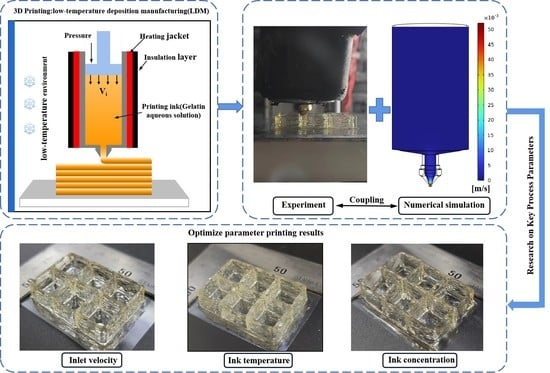A Study of the Gelatin Low-Temperature Deposition Manufacturing Forming Process Based on Fluid Numerical Simulation
Abstract
:1. Introduction
2. Materials and Methods
2.1. Materials
2.2. Measurement of Rheological Properties
2.3. Finite Element Simulation
2.3.1. Simulation Scheme
2.3.2. Conditions and Assumptions
- Assuming that the material was an incompressible fluid;
- Assuming that there was no slip between the material and the cylinder wall during extrusion;
- The piston moved at a constant speed at the inlet. The equivalent inlet velocity boundary conditions were applied on this boundary to replace the constant movement of the piston, with wall normal velocity vn = 0 and surface velocity vs = 0;
- The material was a fluid with high viscosity, whose inertial force and gravity were much smaller than the viscous force, so gravity was ignored;
- The pressure at the nozzle outlet was 101,325 Pa, which was 1 atm;
- The material was fully filled in the mold and stably flowed laminar in the flow channel.
2.3.3. Fluid Viscosity Model
2.3.4. Physical Model
Model Heat Transfer Analysis
The Heat Source and Its Initial Conditions
Heating Condition Setting
2.3.5. Convective Heat Transfer Coefficient
2.3.6. Printing Test
3. Results and Discussion
3.1. Rheological Properties
3.2. Analysis of the Flow Field Distribution in the Flow Channel
3.2.1. Temperature Distribution
3.2.2. Velocity Distribution
3.2.3. Shear Rate Distribution
3.2.4. Viscosity Distribution
3.2.5. Pressure Distribution
3.3. Effect of Inlet Velocity on Flow Field Distribution
3.4. Effect of Initial Gelatin Solution Temperature on Temperature Field Distribution
3.5. Effect of Material Concentration on Flow Field Distribution
3.6. Effect of Nozzle Diameter on Flow Field Distribution
4. Conclusions
Author Contributions
Funding
Data Availability Statement
Conflicts of Interest
References
- Sano, Y.; Matsuzaki, R.; Ueda, M.; Todoroki, A.; Hirano, Y. 3D Printing of Discontinuous and Continuous Fibre Composites Using Stereolithography. Addit. Manuf. 2018, 24, 521–527. [Google Scholar] [CrossRef]
- Zhang, P.J. Simulation Optimization and Material Forming Research of Direct Writing 3D Device Based on Silicon Nitride Ceramics. Ph.D. Thesis, Guangdong University of Technology, Guangzhou, China, 2021. [Google Scholar]
- Zheng, L.; Sun, W.L.; Sun, B. Influence of extrusion methods on the discharging controllability of 3D printing with viscoelastic slurry. J. Mater. Eng. 2020, 48, 134–141. [Google Scholar]
- Liu, C.; Tong, J.; Ma, J.; Wang, D.; Xu, F.; Liu, Y.; Chen, Z.; Lao, C. Low-Temperature Deposition Manufacturing: A Versatile Material Extrusion-Based 3D Printing Technology for Fabricating Hierarchically Porous Materials. J. Nanomater. 2019, 2019, e1291067. [Google Scholar] [CrossRef] [Green Version]
- Yang, F.L.; Guo, C.F.; Zhang, M. Improving 3D printing process of lemon juice gel based on fluid flow numerical simulation. LWT 2019, 102, 89–99. [Google Scholar] [CrossRef] [Green Version]
- Tan, Z.; Parisi, C.; Di Silvio, L.; Dini, D.; Forte, A.E. Cryogenic 3D Printing of Super Soft Hydrogels. Sci. Rep. 2017, 7, 16293. [Google Scholar] [CrossRef] [Green Version]
- Huang, H.J.; Cheng, J.S. Chemical Basis of Collagen and Gelatin Molecules and gel of Gelatin. Sci. Technol. Gelatin 2005, 2, 82–86. [Google Scholar]
- Yang, G.H.; Han, Y. The Effect of Gelatin on the Stability of 3D Printing of Chicken Mince. J. Food Sci. 2021, 43, 51–57. [Google Scholar]
- Liu, Z.B. Study on Extrusion 3D Printing and Post processing Adaptability of Potato Mash and Its Starch Mixed Gel, System; Jiangnan University: Wuxi, China, 2020. [Google Scholar]
- Schuurman, W.; Levett, P.A.; Pot, M.W.; Van Weeren, P.R.; Dhert, W.J.A.; Hutmacher, D.W.; Melchels, F.P.W.; Klein, T.J.; Malda, J. Gelatin-Methacrylamide Hydrogels as Potential Biomaterials for Fabrication of Tissue-Engineered Cartilage Constructs: Gelatin-Methacrylamide Hydrogels as Potential Biomaterials for Fabrication. Macromol. Biosci. 2013, 13, 551–561. [Google Scholar] [CrossRef]
- Kim, G.; Ahn, S.; Yoon, H.; Kim, Y.; Chun, W. A Cryogenic Direct-Plotting System for Fabrication of 3D Collagen Scaffolds for Tissue Engineering. J. Mater. Chem. 2009, 19, 8817–8823. [Google Scholar] [CrossRef]
- Gu, Y.; Zhang, L.; Du, X.; Fan, Z.; Wang, L.; Sun, W.; Cheng, Y.; Zhu, Y.; Chen, C. Reversible Physical Crosslinking Strategy with Optimal Temperature for 3D Bioprinting of Human Chondrocyte-Laden Gelatin Methacryloyl Bioink. J. Biomater. Appl. 2018, 33, 609–618. [Google Scholar] [CrossRef]
- Levett, P.A.; Melchels, F.P.W.; Schrobback, K.; Hutmacher, D.W.; Malda, J.; Klein, T.J. Chondrocyte Redifferentiation and Construct Mechanical Property Development in Single-Component Photocrosslinkable Hydrogels: Chondrocyte Redifferentiation and Construct Mechanical Property Development. J. Biomed. Mater. Res. A 2014, 102, 2544–2553. [Google Scholar] [CrossRef] [PubMed]
- Levett, P.A.; Melchels, F.P.W.; Schrobback, K.; Hutmacher, D.W.; Malda, J.; Klein, T.J. A Biomimetic Extracellular Matrix for Cartilage Tissue Engineering Centered on Photocurable Gelatin, Hyaluronic Acid and Chondroitin Sulfate. Acta Biomater. 2014, 10, 214–223. [Google Scholar] [CrossRef] [PubMed] [Green Version]
- Zhao, T.Y. Design and Experimental Study of the Mechanical System of an Extrusion-Based Bio-3D Printer; Harbin Institute of Technology: Harbin, China, 2019. [Google Scholar]
- Gao, Q.; Yu, K.; Chen, F.; Lu, L.; Zhang, P. Investigation on the Temperature Distribution Uniformity of an Extrusion-Based 3D Print Head and Its Temperature Control Strategy. Pharmaceutics 2022, 14, 2108. [Google Scholar] [CrossRef]
- Chen, X.L. Numerical Simulation of Gelatin Physical Gelatin Processes under Non-Uniform Temperature Field. Ph.D. Thesis, Shandong University, Jinan, China, 2010. [Google Scholar]
- Kavimughil, M.; Leena, M.M.; Moses, J.A.; Anandharamakrishnan, C. Effect of Material Composition and 3D Printing Temperature on Hot-Melt Extrusion of Ethyl Cellulose Based Medium Chain Triglyceride Oleogel. J. Food Eng. 2022, 329, 111055. [Google Scholar] [CrossRef]
- Xu, J.; Wang, N.; Severini, C. Fluent-based fluid simulation of a cigarette machine hitch gun nozzle. Packag. J. 2022, 14, 36–41. [Google Scholar] [CrossRef]
- Gao, Q.; Lu, L.; Zhang, R.; Song, L.; Huo, D.; Wang, G. Investigation on the Thermal Behavior of an Aerostatic Spindle System Considering Multi-Physics Coupling Effect. Int. J. Adv. Manuf. Technol. 2019, 102, 3813–3823. [Google Scholar] [CrossRef]
- Derossi, A.; Caporizzi, R.; Azzollini, D.; Severini, C. Application of 3D Printing for Customized Food. A Case on the Development of a Fruit-Based Snack for Children. J. Food Eng. 2018, 220, 65–75. [Google Scholar] [CrossRef]
- Lille, M.; Nurmela, A.; Nordlund, E.; Metsä-Kortelainen, S.; Sozer, N. Applicability of Protein and Fiber-Rich Food Materials in Extrusion-Based 3D Printing. J. Food Eng. 2018, 220, 20–27. [Google Scholar] [CrossRef]
- Liu, Z. Impact of Rheological Properties of Mashed Potatoes on 3D Printing. J. Food Eng. 2018, 9, 76–82. [Google Scholar] [CrossRef] [Green Version]
- Eidam, D.; Kulicke, W.-M.; Kuhn, K.; Stute, R. Formation of Maize Starch Gels Selectively Regulated by the Addition of Hydrocolloids. Starch—Stärke 1995, 47, 378–384. [Google Scholar] [CrossRef]
- Rueda, M.M.; Auscher, M.-C.; Fulchiron, R.; Périé, T.; Martin, G.; Sonntag, P.; Cassagnau, P. Rheology and Applications of Highly Filled Polymers: A Review of Current Understanding. Prog. Polym. Sci. 2017, 66, 22–53. [Google Scholar] [CrossRef]
- Liu, Q.; Zhang, N.; Wei, W.; Hu, X.; Tan, Y.; Yu, Y.; Deng, Y.; Bi, C.; Zhang, L.; Zhang, H. Assessing the Dynamic Extrusion-Based 3D Printing Process for Power-Law Fluid Using Numerical Simulation. J. Food Eng. 2020, 275, 109861. [Google Scholar] [CrossRef]
- Shamsudin, R.; Mohamed, I.O.; Nooi, T.S. Rheological properties of cocoa butter substitute (CBS): Effects of temperature and characteristics of fatty acids on viscocity. J. Food Lipids 2006, 13, 402–410. [Google Scholar] [CrossRef]
- Valkenaers, H.; Jansen, D.; Voet, A.; Van Gysel, A.; Ferraris, E. Additive manufacturing for concrete a 3D printing principle. In Proceedings of the 14th Euspen International Conference, Dubrovnik, Croatia, 2–6 June 2014. [Google Scholar]
- Emin, M.A. Analysis of the Dispersive Mixing Efficiency in a Twin-Screw Extrusion Processing of Starch Based Matrix. J. Food Eng. 2013, 115, 132–143. [Google Scholar] [CrossRef]
- Yan, C.F. Extrusion Process of Freeze-form Extrusion Fabrication for Ceramics Material. Bull. Am. Ceram. Soc. 2015, 34, 3073–3077. [Google Scholar]
- Cao, W.J.; Ma, Z.Y. Dimensional accuracy of wire formed by 3D low temperature deposition of sodium alginate/gelatin solution. Mech. Eng. 2018, 42, 12. [Google Scholar] [CrossRef]
- Guo, L.; Colby, R.H.; Lusignan, C.P.; Howe, A.M. Physical Gelation of Gelatin Studied with Rheo-Optics. Macromolecules 2003, 36, 10009–10020. [Google Scholar] [CrossRef]
- He, S.; Huang, H.J. Preliminary Study on Gelatin Hydrogels with Different Concentrations for 3D Bioprinting. Mech. Eng. 2021, 4, 148–153. [Google Scholar]
- Oyinloye, T.M.; Yoon, W.B. Investigation of Flow Field, Die Swelling, and Residual Stress in 3D Printing of Surimi Paste Using the Finite Element Method. Innov. Food Sci. Emerg. Technol. 2022, 78, 103008. [Google Scholar] [CrossRef]
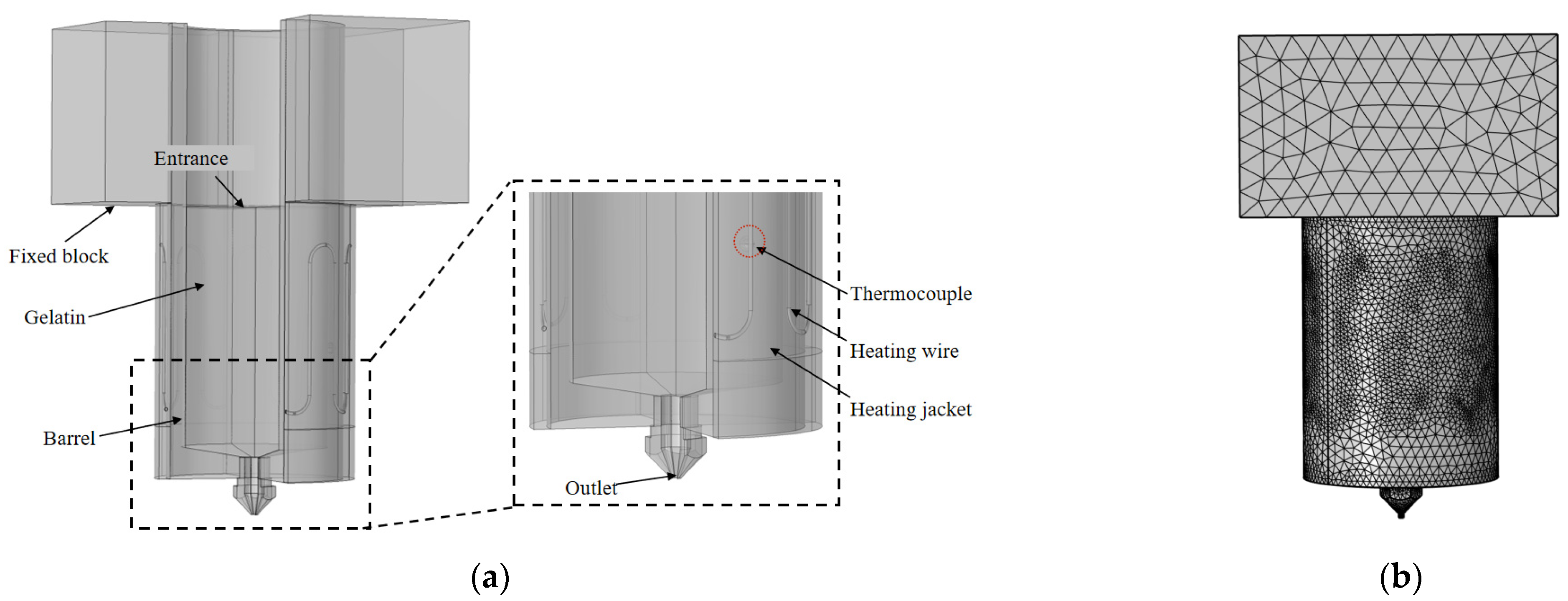
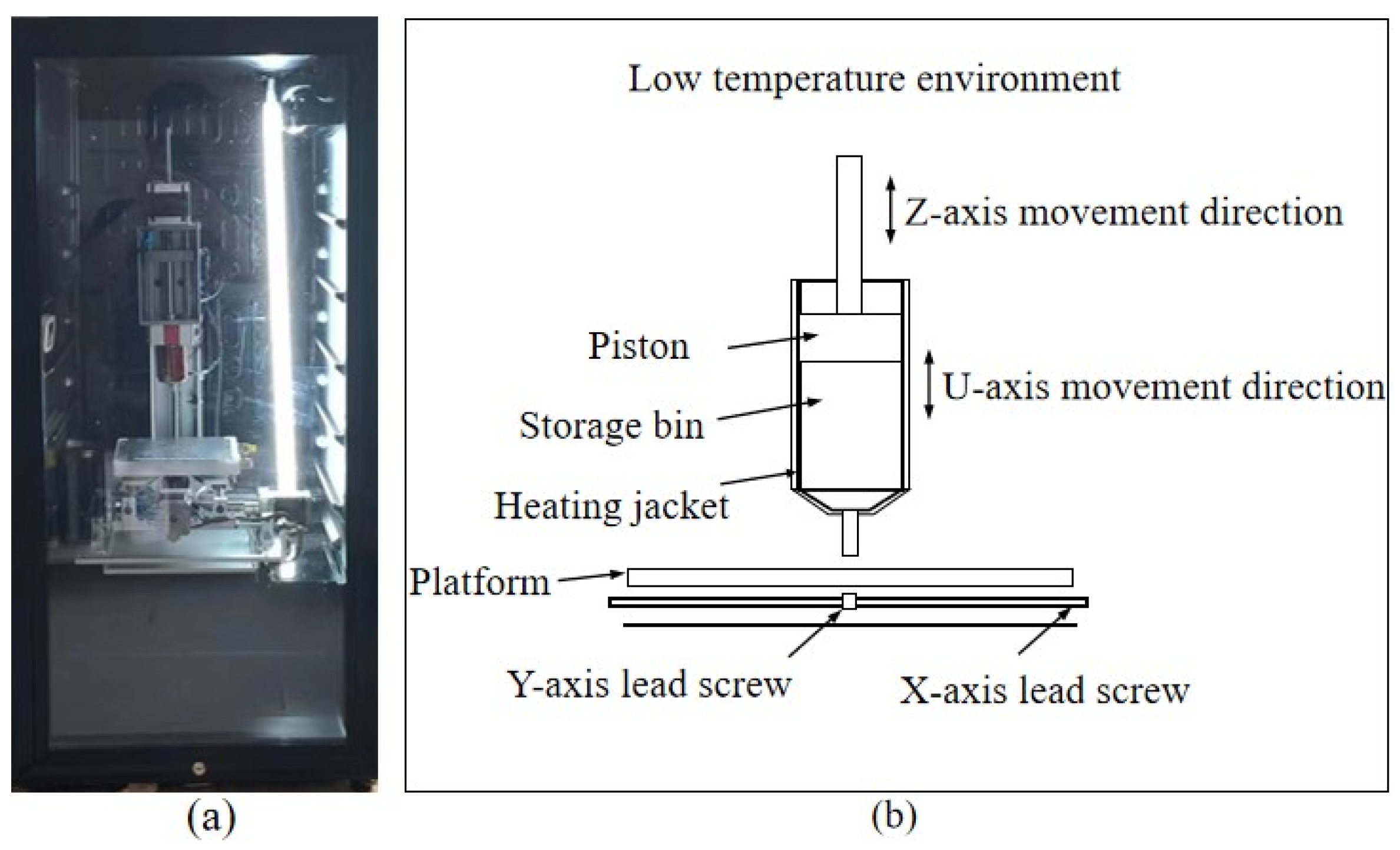
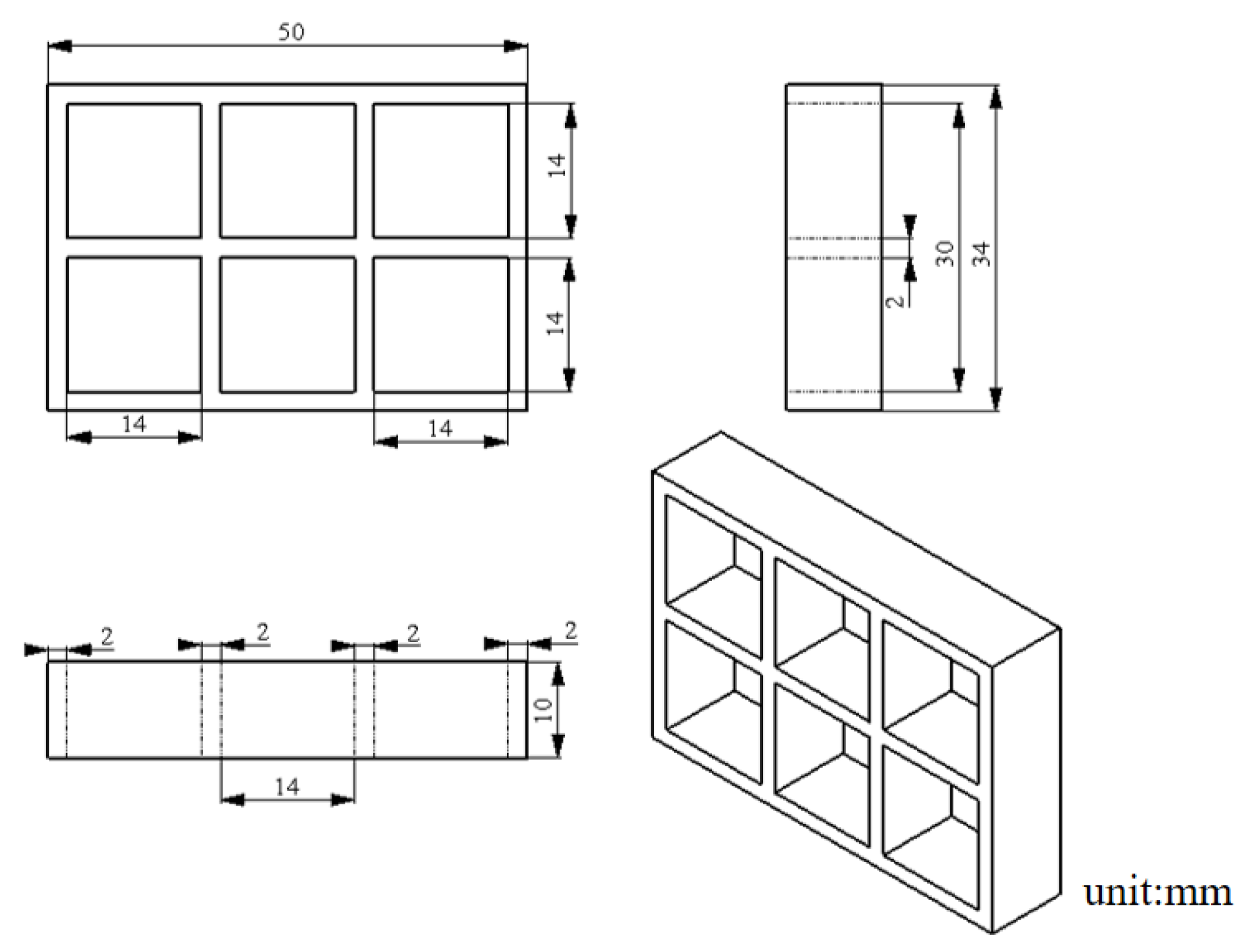
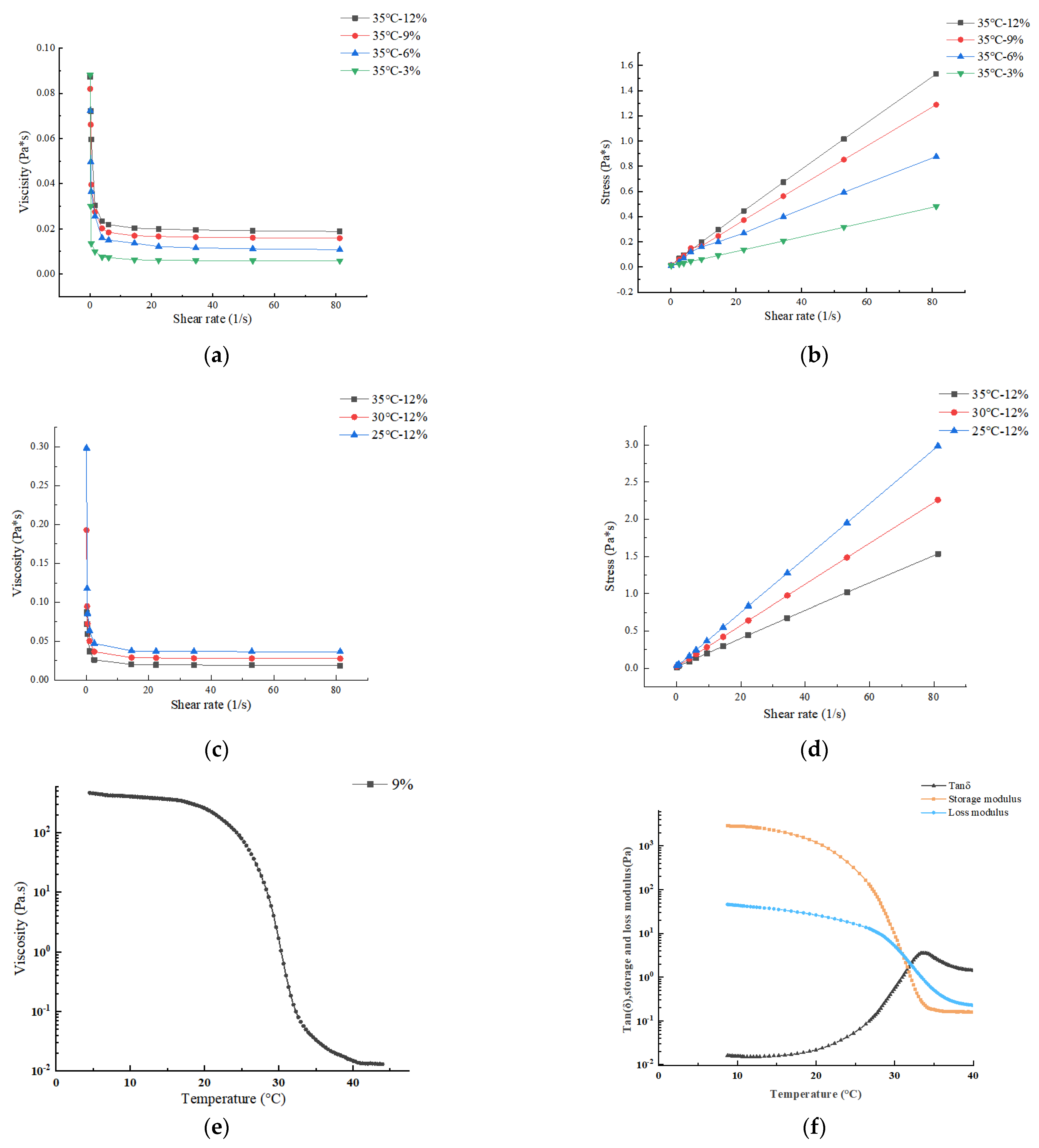
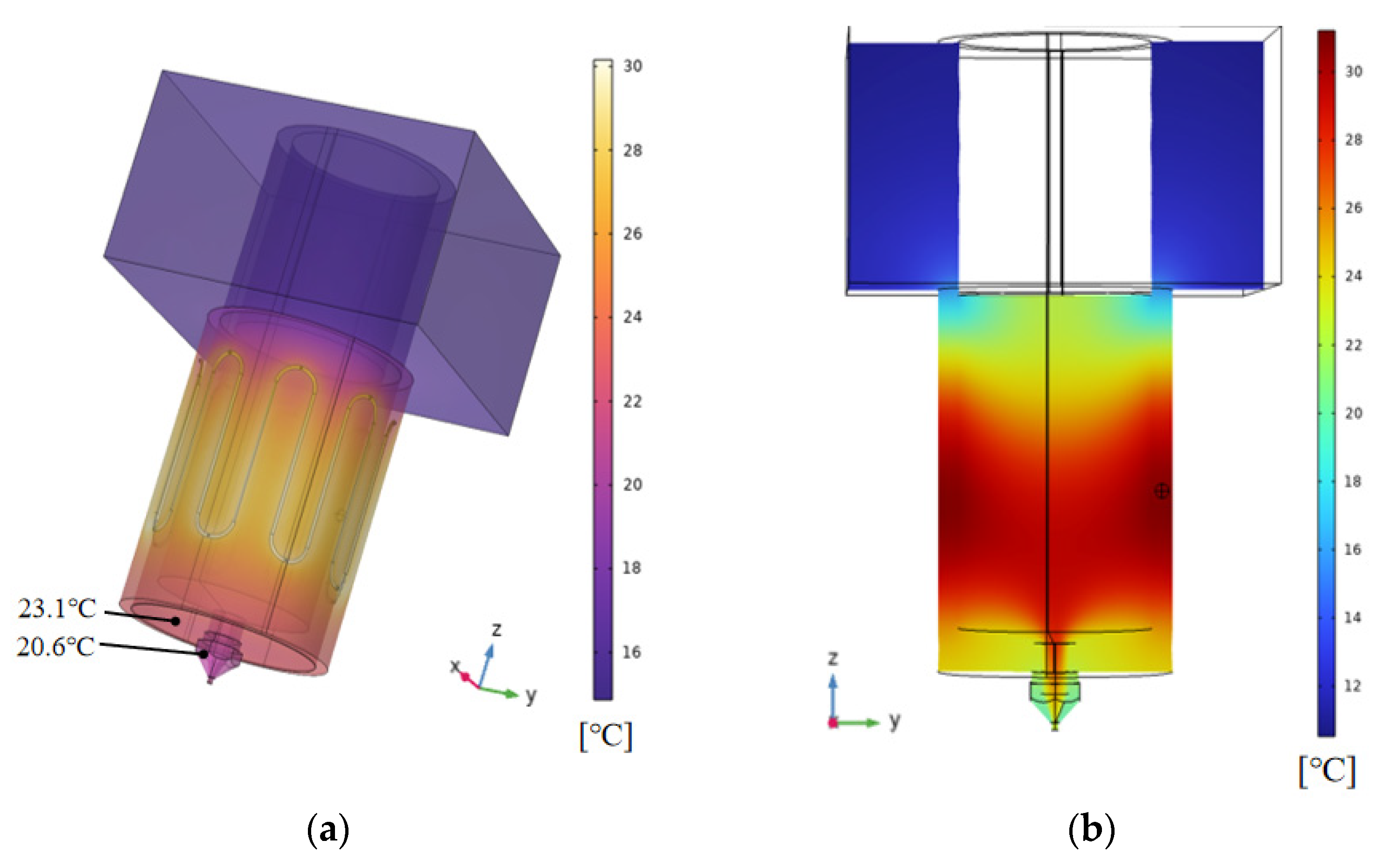
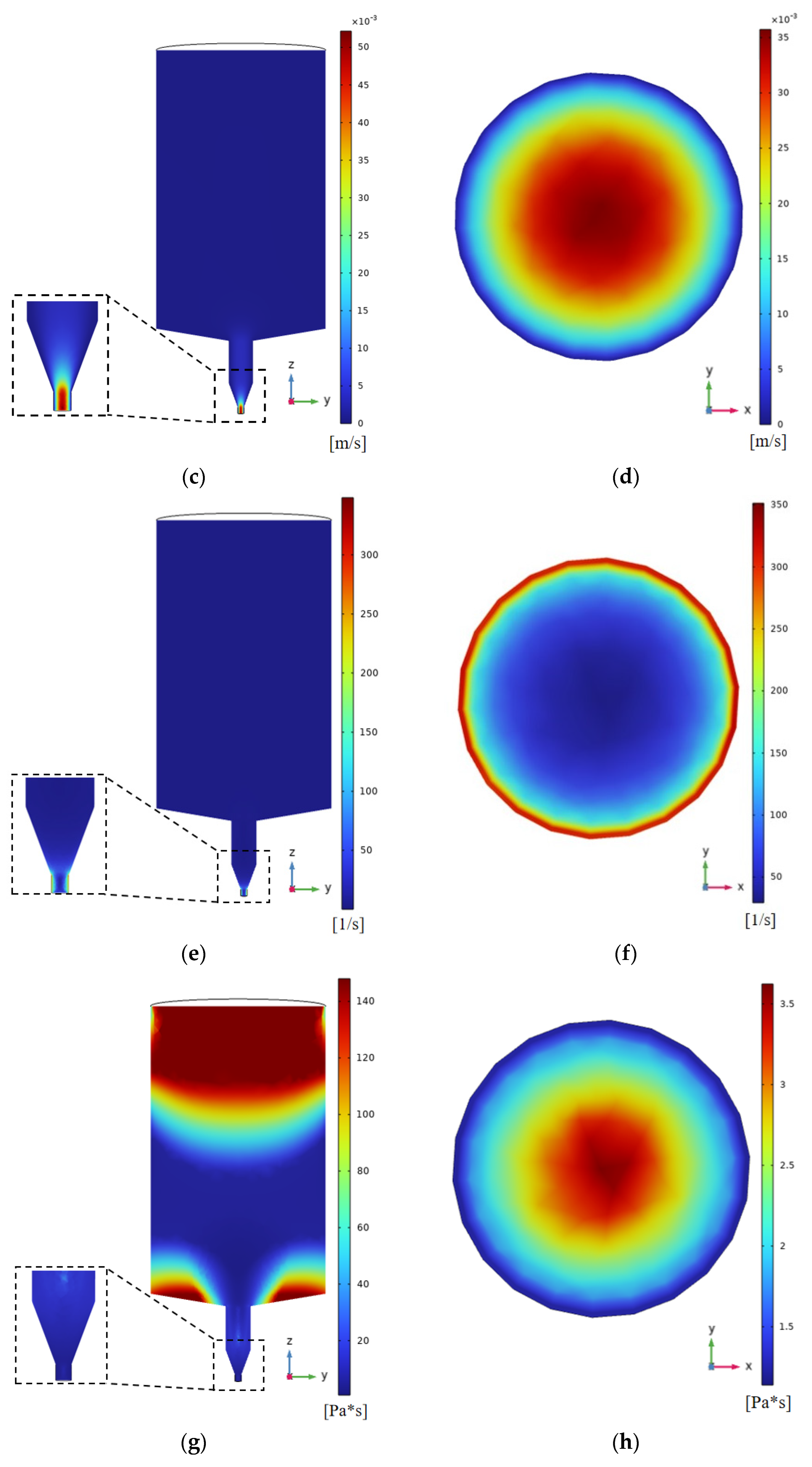
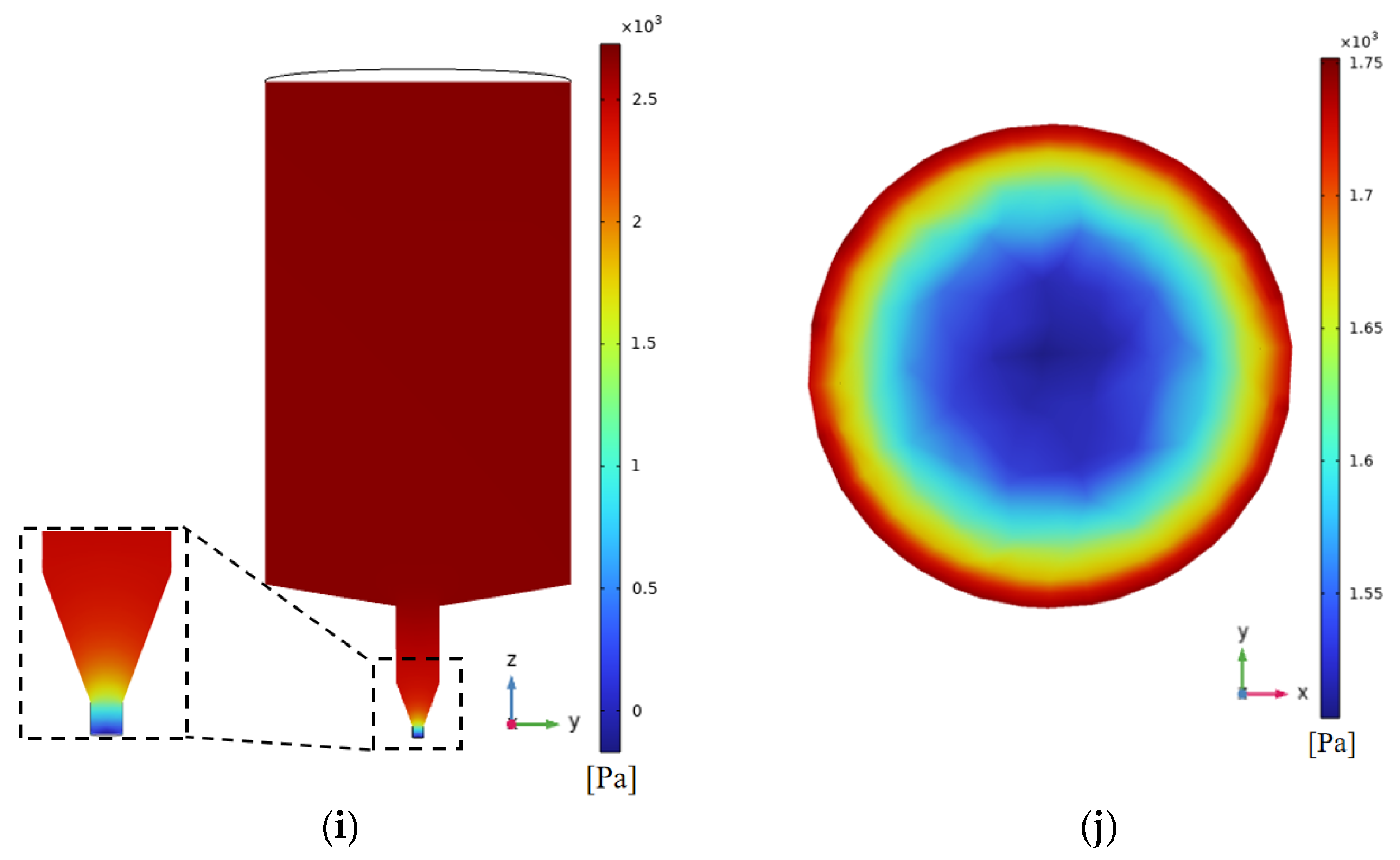
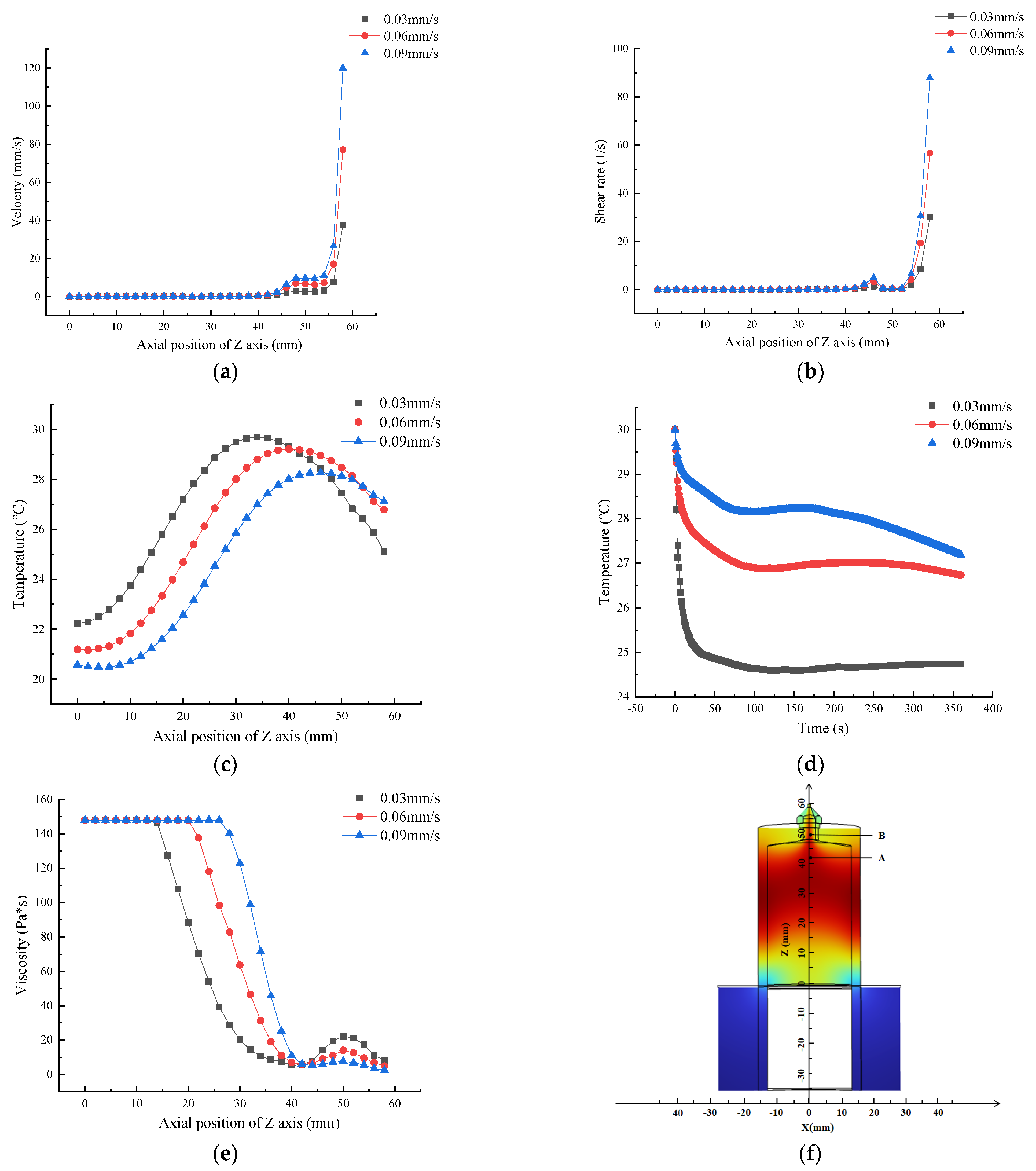
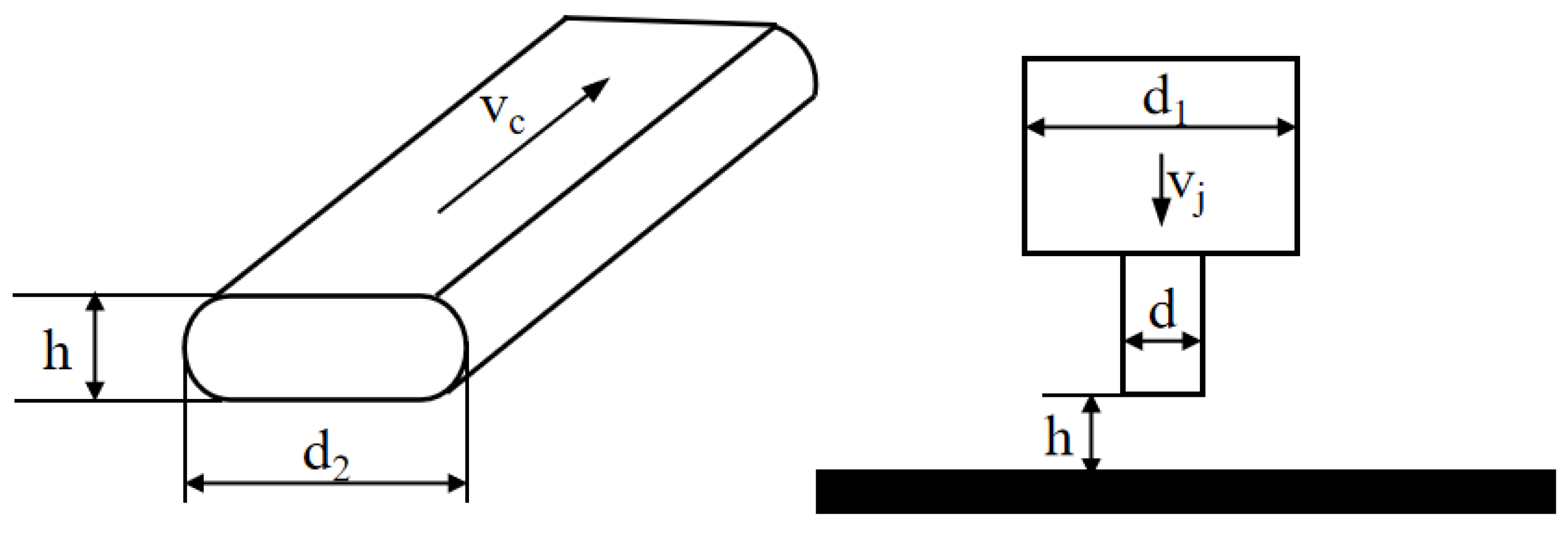

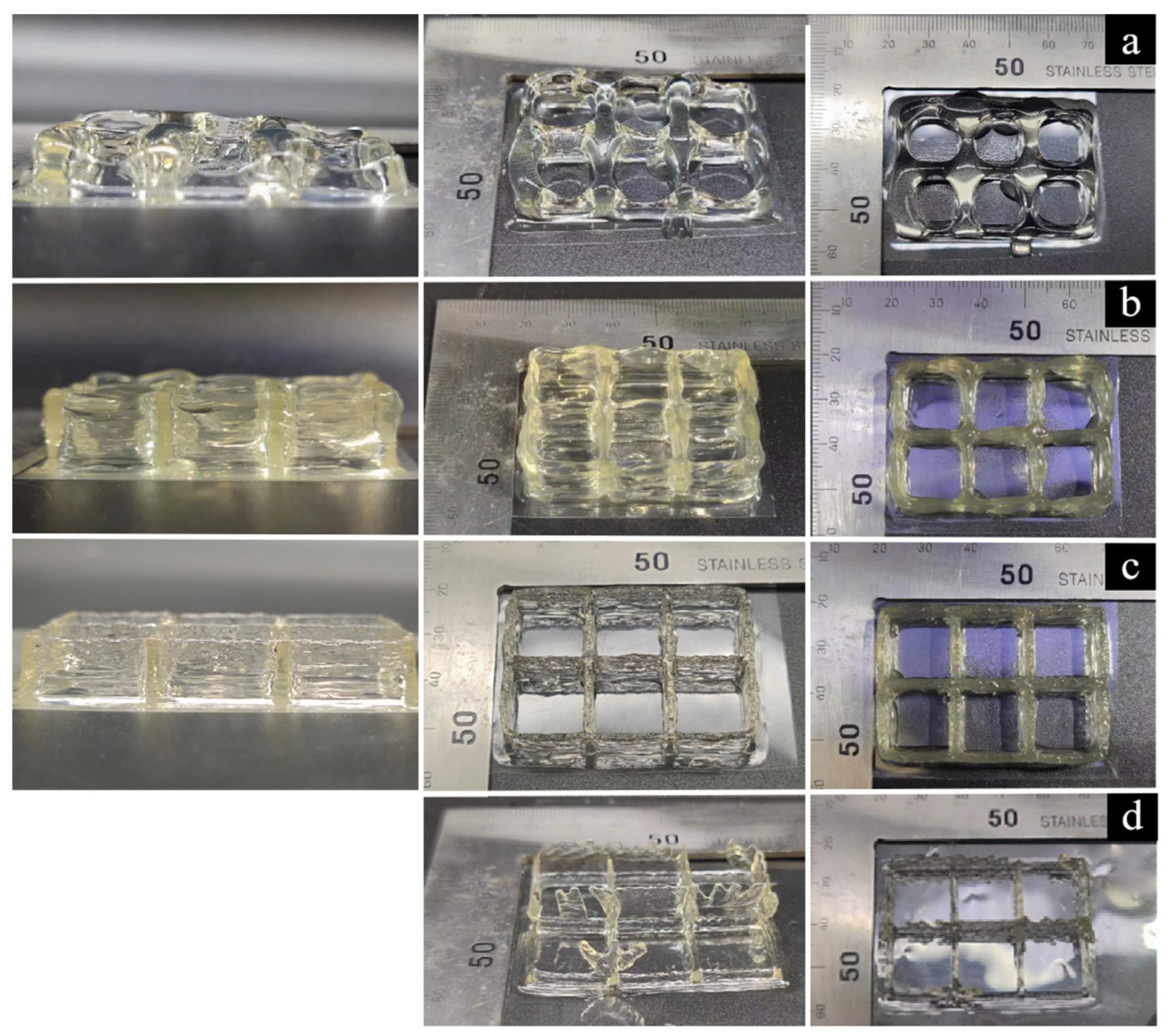
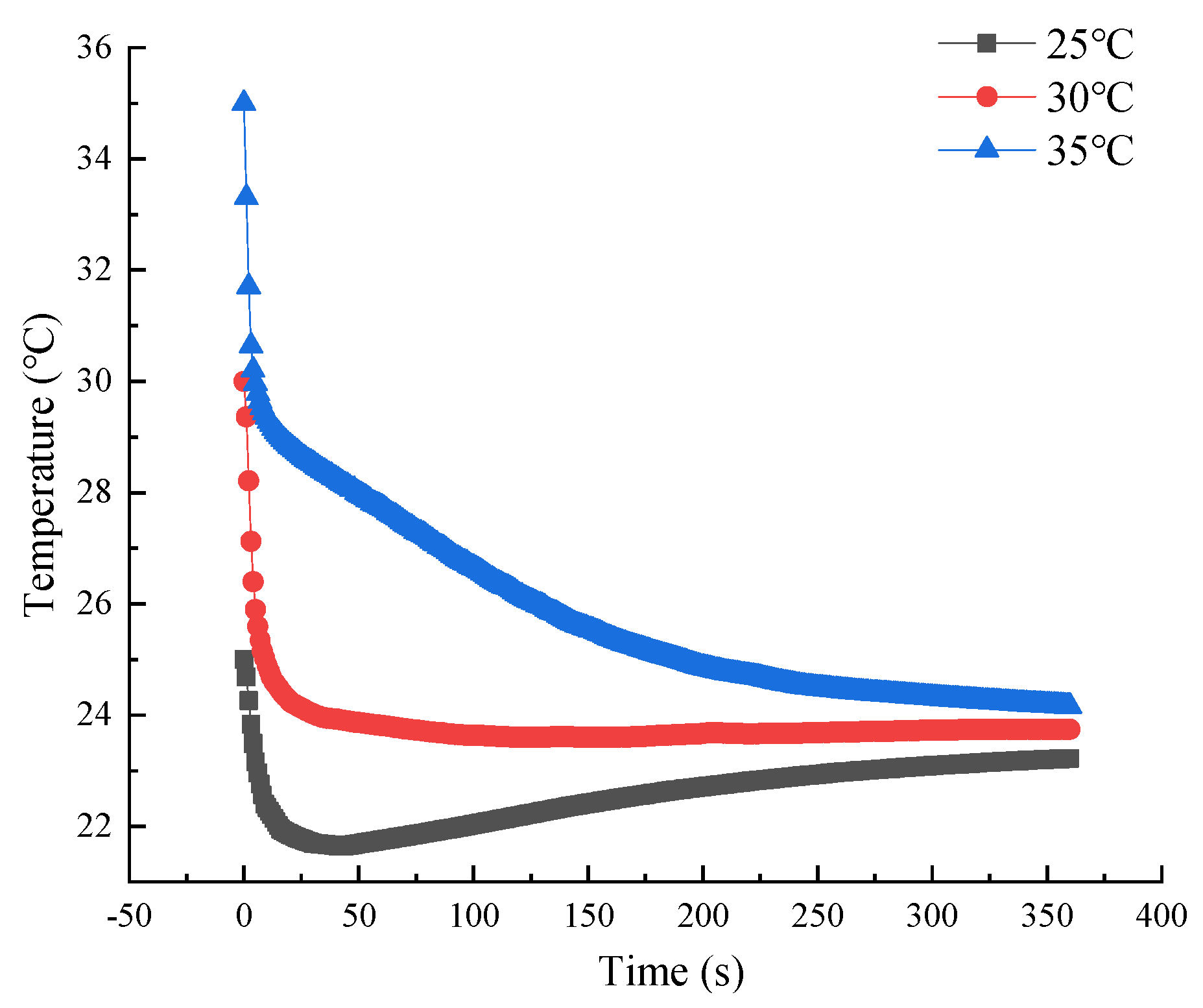
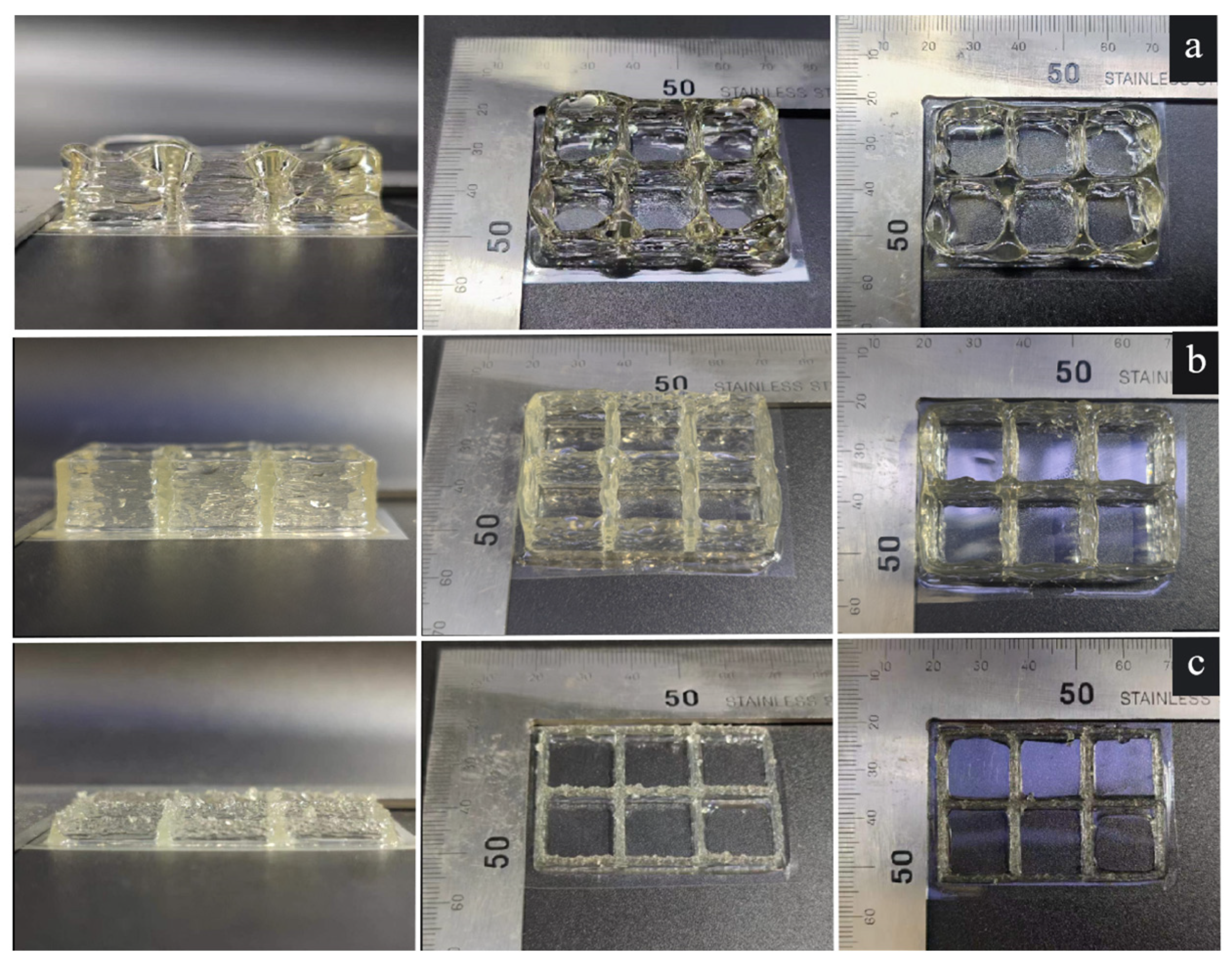

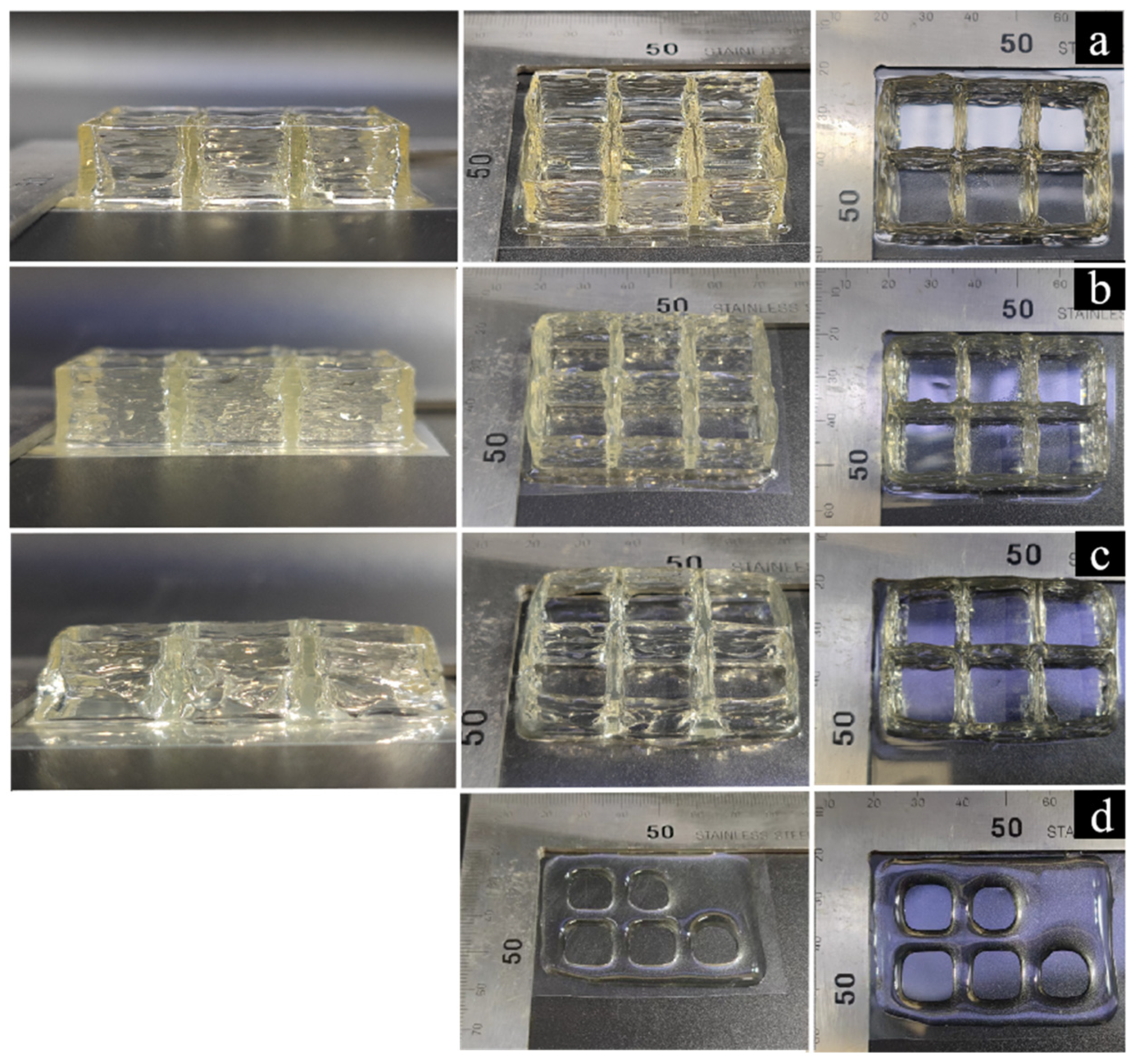

Disclaimer/Publisher’s Note: The statements, opinions and data contained in all publications are solely those of the individual author(s) and contributor(s) and not of MDPI and/or the editor(s). MDPI and/or the editor(s) disclaim responsibility for any injury to people or property resulting from any ideas, methods, instructions or products referred to in the content. |
© 2023 by the authors. Licensee MDPI, Basel, Switzerland. This article is an open access article distributed under the terms and conditions of the Creative Commons Attribution (CC BY) license (https://creativecommons.org/licenses/by/4.0/).
Share and Cite
Tong, Q.; Zhao, W.; Guo, T.; Wang, D.; Dong, X. A Study of the Gelatin Low-Temperature Deposition Manufacturing Forming Process Based on Fluid Numerical Simulation. Foods 2023, 12, 2687. https://doi.org/10.3390/foods12142687
Tong Q, Zhao W, Guo T, Wang D, Dong X. A Study of the Gelatin Low-Temperature Deposition Manufacturing Forming Process Based on Fluid Numerical Simulation. Foods. 2023; 12(14):2687. https://doi.org/10.3390/foods12142687
Chicago/Turabian StyleTong, Qiang, Wentao Zhao, Tairong Guo, Dequan Wang, and Xiuping Dong. 2023. "A Study of the Gelatin Low-Temperature Deposition Manufacturing Forming Process Based on Fluid Numerical Simulation" Foods 12, no. 14: 2687. https://doi.org/10.3390/foods12142687



